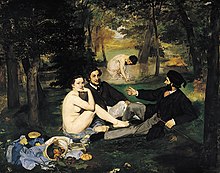User:Ahoneck/sandbox
| Le Déjeuner sur l'herbe | |
|---|---|
 Central panel, Musée d'Orsay | |
| Artist | Claude Monet |
| Medium | Oil on canvas |
| Dimensions | 248.9 cm × 218.0 cm (98.0 in × 85.8 in) |
| Location | Musée d'Orsay, Paris |

Le Déjeuner sur l'herbe (English: Luncheon on the Grass) is an 1865–1866 oil on canvas painting by Claude Monet, produced in response to the 1863 work of the same title by Édouard Manet. It remains unfinished, but two large fragments (central and left panels) are now in the Musée d'Orsay in Paris,[1][2] while a smaller 1866 version is now in the Pushkin Museum in Moscow.[3] Monet originally wanted to submit the painting to the Salon jury of 1866, though he underestimated how long it would take him to recreate his sketches onto a life size canvas, so it remained unfinished.
The painting is in fragments due to Monet's financial state at the time. He was unable to pay his rent, and had to offer up Déjeuner to his landlord. When he bought it back from his landlord, it had water damage. [4]: 15–17 Monet had to cut it up in order to preserve the non-damaged parts.[4]: 15–17
Description
[edit]The painting depicts twelve people clothed in Parisian fashion of the time. They are having a picnic near a forest glade. The people are gathered around a white picnic blanket, surrounded by fruits, cake and wine. The mood in this natural space is primarily created by the play of light and shadow, caused by the deciduous tree above them. Monet favored light-tone priming to help achieve the luminosity in his paintings.[5]: 6 According to John House, the lighting in Monet's version of the scene resembles “sparkling light effects” of nature, which differs from Manet's original that resembles studio light.[5]: 6
While Monet’s painting was inspired by Manet, it carries a different message from the original work. Joel Isaacson observes that at the time the dream of every painter, according to Emile Zola, was to "put life-size figures in a landscape".[4]: 15 According to Joel Isaacson, Monet intended to paint the picnic in a contemporary and objective manner, thus avoiding “artificialities” in Manet’s version.[4] : 15 He hoped to depict “freshness and immediacy” and he did so through having an informal figure grouping.[5]: 34
Influence
[edit]
Many different paintings have been said to influence Monet's recreation of Le Déjeuner sur l'herbe. In addition to the original Déjeuner being an influence, Joel Isaacson believes that Monet also drew elements from Manet's La Musique aux Tuileries.[4]: 32–33 Mary Gedo Matthews believes that in his painting, Monet did not hope to pay homage, instead he wanted to demonstrate that his vision was superior to Manet’s.[6] The artist's different messages likely came from their vastly dissimilar personalities and socioeconomic status'.[6] Manet took pride in distancing himself from public displays of emotions in his paintings, whereas Monet was more direct with his feelings which was fueled by his ambition. [6]: 32–33
It is possible some of Gustave Courbet’s work influenced Monet as well. Specifically, The Hunt Breakfast. Mary Matthews Gedo speculates this due to the similar breakfast scene depicted, and the large scale of both paintings. [6]: 33 Monet portrayed Courbet in the painting, as well as his dear friend Bazille, whom he depended on heavily, and is depicted four times in the original composition of the painting (The Moscow Sketch), before it was cut up.[5]: 59

Stylistic elements
[edit]
Monet's use of color is notable throughout the painting. He used bright accents on the dress in the left panel. André Dombrowski describes it as "an unnatural visual siren that pierces the overall harmony of the scene"[7]: 45 Déjeuner promotes integration through blending both colors and foreground to background, while also appreciating the use of a single brush stroke.[7]: 45
The painting stands out through its bold and emphatic brushwork; Monet is known for having nervous and intense brushwork.[7]: 42–43 The impressionist painter was too impatient to create a gradient, so there are large patches of light.[7]: 42–43 It was meant to be set entirely in the present, modern and contemporary, without the use of tradition, in contrast to Manet’s approach.[8]
- ^ "Le Déjeuner sur l'herbe (partie gauche)". musee-orsay.fr.
- ^ "Le Déjeuner sur l'herbe (panneau central)". musee-orsay.fr.
- ^ "Déjeuner sur l'herbe". newestmuseum.ru.
- ^ a b c d e Isaacson, Joel (1972). Le déjeuner sur l’herbe. London: Allen Lane the Penguin Press. p. 19.
- ^ a b c d House, John (1996). Monet. London: Phaidon Press Limited. p. 34.
- ^ a b c d Gedo, Mary Matthews (2010). Monet and His Muse: Camille Monet in the Artist’s Life. Chicago: The University of Chicago Press. p. 32.
- ^ a b c d Dombrowski, André (2023). Monet's Minutes: Impressionism and the Industrialization of Time. New Haven & London: Yale University Press.
- ^ Koja, Stephan (1996). Claude Monet. Munich & New York: Prestel-Verlag.
